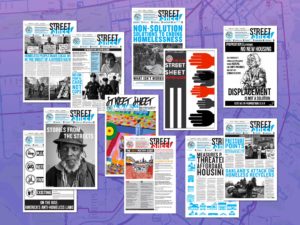What better way to foster a community of empathetic and understanding individuals than by shaping the perspective of our children, who will one day act as allies, friends, leaders, freethinkers and aware members of society?
This is the question Mike Boyce, a senior at California College of the Arts double majoring in Graphic Design and Illustration, focuses on in his final project—a children’s book that tries to make visible what many people intentionally hope remains invisible: homelessness.
Boyce’s book, Who’s Homeless?, provides elementary school kids with an honest and eye-opening perspective of San Francisco’s homeless population. While many may be too afraid or too indifferent to engage, Boyce invests his time in creating “art that matters,” starting dialogue about empathy and humanity early on in the minds of those who are the most curious and influential.
From Ohio, to New York, to San Diego, and then to San Francisco, Boyce notes his shock at not only the amount of people living on the streets, but also the lack of programs and support provided for them.
“There’s a huge lack of support. People take cars through the Tenderloin to avoid it,” he says. “The issue stems from the perspectives formed early on … These are real people, with real lives. I’m trying to break down those preconceived notions.”
Boyce’s idea to write and illustrate a children’s book stemmed from interviews he conducted with those camping out around his school. He asked them various questions about living arrangements and moving to San Francisco, however noted that one difficulty in particular stood out amongst the rest—“the way children looked at [them] … with fear. And, who wants to see a kid looking at you like that?”
Boyce went on to note that he also asked parents about how they explain homelessness to their children, stating that many of them “rush their kids away, telling them not to look.” Intrigued by the fear of having to explain homelessness on behalf of the parents, he researched existing children’s books that touch on encampments and found that many merely put a band-aid on an open wound. “Being homeless can be anyone. Open the doors to dialogue about what these kids are seeing everyday.”
Boyce brings his project to fruition by reading to children at Turk Elementary School in order to assess if his targeted audience fully grasps his intention of viewing the experiences of homelessness with empathy, rather than rebuke. He challenges negative preconceived notions of the homeless by portraying scenes that passers-by may not notice. Instead of showing a disheveled, poorly groomed man sitting on the street drinking beer, he shows a veteran standing in line for support services. Instead of showing a woman slouched on the curb with a sign asking for money, he depicts a family, including children, setting up their tent on the sidewalk. By doing this, he portrays individuals and families in a positive light to help dispel potentially harmful stigmas.
Boyce tells the story of those experiencing homelessness from the perspective of someone who has the willingness to sit and listen to their stories. And that is exactly what he hopes to instill in these young minds: sit and listen. Be there and be open. Boyce’s conclusion strays from the typical “the end” as many children’s stories do; instead he asks a question, “How can you help?” Without a doubt, hands rise. ≠


